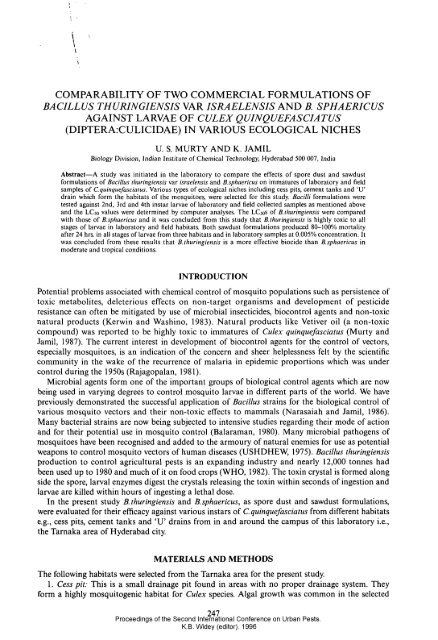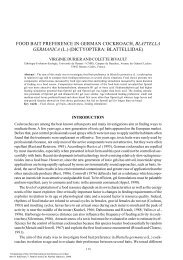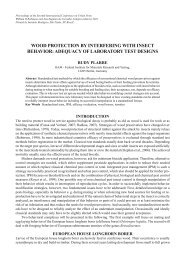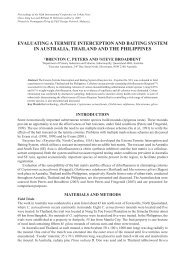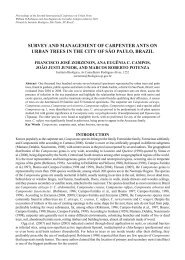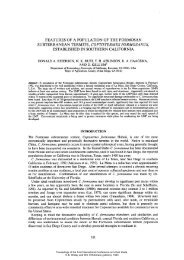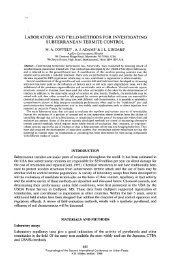Full paper - International Conference on Urban Pests
Full paper - International Conference on Urban Pests
Full paper - International Conference on Urban Pests
Create successful ePaper yourself
Turn your PDF publications into a flip-book with our unique Google optimized e-Paper software.
COMPARABILITY OF TWO COMMERCIAL FORMULATIONS OF<br />
BACILLUS THURINGIENSIS VAR ISRAELENSIS AND B. SPHAERICUS<br />
AGAINST LARVAE OF CULEX QUINQUEFASCIATUS<br />
(D1PTERA:CULICIDAE) IN VARIOUS ECOLOGICAL NICHES<br />
U. S. MURTY AND K. JAMIL<br />
Biology Divisi<strong>on</strong>, Indian Institute of Chemical Technology, Hyderabad 500 007, India<br />
Abstract-A study was initiated in the laboratory to compare the effects of spore dust and sawdust<br />
formulati<strong>on</strong>s of Bacillus thuringiensis var israeler~sis and B.sphaericus <strong>on</strong> immatures of laboratory and field<br />
samples of C.quinquefasciatus. Various types of ecological niches including cess pits, cement tanks and 'U'<br />
drain which form the habitats of the mosquitoes, were selected for this study. Bacilli formulati<strong>on</strong>s were<br />
tested against 2nd, 3rd and 4th instar larvae of laboratory and field collected samples as menti<strong>on</strong>ed above<br />
and the LC50 values were determined by computer analyses. The LCsos of B.t/luringiensis were compared<br />
with those of B.sphaericus and it was c<strong>on</strong>cluded from this study that B.rhuringiensis is highly toxic to all<br />
stages of larvae in laboratory and field habitats. Both sawdust formulati<strong>on</strong>s produced 80-100% mortality<br />
after 24 hrs. in all stages of larvae from three habitats and in laboratory samples at 0.005% c<strong>on</strong>centrati<strong>on</strong>. It<br />
was c<strong>on</strong>cluded from these results that B.rhuringiensis is a more effective biocide than B.spkuericus in<br />
moderate and tropical c<strong>on</strong>diti<strong>on</strong>s.<br />
INTRODUCTION<br />
Potential problems associated with chemical c<strong>on</strong>trol of mosquito populati<strong>on</strong>s such as persistence of<br />
toxic metabolites, deleterious effects <strong>on</strong> n<strong>on</strong>-target organisms and development of pesticide<br />
resistance can often be mitigated by use of microbial insecticides, bioc<strong>on</strong>trol agents and n<strong>on</strong>-toxic<br />
natural products (Kerwin and Washino, 1983). Natural products like Vetiver oil (a n<strong>on</strong>-toxic<br />
compound) was reported to be highly toxic to immatures of Culex quinquefasciatus (Murty and<br />
Jamil, 1987). The current interest in development of bioc<strong>on</strong>trol agents for the c<strong>on</strong>trol of vectors,<br />
especially mosquitoes, is an indicati<strong>on</strong> of the c<strong>on</strong>cern and sheer helplessness felt by the scientific<br />
community in the wake of the recurrence of malaria in epidemic proporti<strong>on</strong>s which was under<br />
c<strong>on</strong>trol during the 1950s (Rajagopalan, 1981).<br />
Microbial agents form <strong>on</strong>e of the important groups of biological c<strong>on</strong>trol agents which are now<br />
being used in varying degrees to c<strong>on</strong>trol mosquito larvae in different parts of the world. We have<br />
previously dem<strong>on</strong>strated the successful applicati<strong>on</strong> of Bacillus strains for the biological c<strong>on</strong>trol of<br />
various mosquito vectors and their n<strong>on</strong>-toxic effects to mammals (Narasaiah and Jamil, 1986).<br />
Many bacterial strains are now being subjected to intensive studies regarding their mode of acti<strong>on</strong><br />
and for their potential use in mosquito c<strong>on</strong>trol (Balaraman, 1980). Many microbial pathogens of<br />
mosquitoes have been recognised and added to the armoury of natural enemies for use as potential<br />
weap<strong>on</strong>s to c<strong>on</strong>trol mosquito vectors of human diseases (USHDHEW, 1975). Bacillus thuringiensis<br />
producti<strong>on</strong> to c<strong>on</strong>trol agricultural pests is an expanding industry and nearly 12,000 t<strong>on</strong>nes had<br />
been used up to 1980 and much of it <strong>on</strong> food crops (WHO, 1982). The toxin crystal is formed al<strong>on</strong>g<br />
side the spore, larval enzymes digest the crystals releasing the toxin within sec<strong>on</strong>ds of ingesti<strong>on</strong> and<br />
larvae are killed within hours of ingesting a lethal dose.<br />
In the present study B. thuringiensis and B.sphaericus, as spore dust and sawdust formulati<strong>on</strong>s,<br />
were evaluated for their efficacy against various instars of C. quinquefasciatus from different habitats<br />
e.g., cess pits, cement tanks and 'U' drains from in and around the campus of this laboratory i.e.,<br />
the Tarnaka area of Hyderabad city.<br />
MATERIALS AND METHODS<br />
The following habitats were selected from the Tarnaka area for the present study.<br />
1. Cess pit: This is a small drainage pit found in areas with no proper drainage system. They<br />
form a highly mosquitogenic habitat for Culex species. Algal growth was comm<strong>on</strong> in the selected<br />
247.<br />
Proceedings of the Sec<strong>on</strong>d lnternat~<strong>on</strong>al <str<strong>on</strong>g>C<strong>on</strong>ference</str<strong>on</strong>g> <strong>on</strong> <strong>Urban</strong> <strong>Pests</strong>.<br />
K.B. Widey (editor). 1996
248 U. S. MURTY AND K. JAMIL<br />
pit and it was inhabited by Drag<strong>on</strong> fly naiads, water bugs, tadpoles and crustaceans which can be<br />
c<strong>on</strong>sidered as associated fauna.<br />
2. Cement Tank: The tank selected for this study measured 12'x6'x6' and was situated in the<br />
campus. Water hyacinth (Eichhornia crassipes) was the predominant flora in the tank which formed<br />
a major breeding site for mosquitoes. Decaying organic matter such as leaves, straw green grass and<br />
other debris was present and it was observed that C.quinquefasciatus was the predominant<br />
mosquito species in this tank.<br />
3. 'U' drain" : The open drainage system in the Tarnaka area formed a major source of breeding<br />
for mosquitoes. The total length of the open drain was 300-350 m. and it c<strong>on</strong>tained stagnant water<br />
due to the c<strong>on</strong>tinuous disposal of domestic wastes and this was associated with heavy mosquito<br />
breeding. The predominant mosquito species in this habitat was C.quinquefasciatus.<br />
Bacterial formulati<strong>on</strong>s<br />
Bacillus thuringiensis and B. sphaericus: Freeze dried spore formulati<strong>on</strong>s and sawdust formulati<strong>on</strong>s<br />
were dissolved in sterilised water and different c<strong>on</strong>centrati<strong>on</strong>s were prepared for the bioassay.<br />
Bioassay: 25 larvae of each instar from each habitat were seeded in 5001111 beakers c<strong>on</strong>taining<br />
249 ml of water. lml of test suspensi<strong>on</strong> of each c<strong>on</strong>centrati<strong>on</strong> was added to the each beaker and the<br />
laboratory bred larvae were used as c<strong>on</strong>trols and assayed as above. All the experiments were d<strong>on</strong>e<br />
in triplicate. Mortality was recorded after 24 hrs and the results were computerised according to<br />
Finney's method (1971).<br />
RESULTS AND DISCUSSION<br />
The data obtained from the 4 test strains of B. thuringiensis and B.sphaericus against all immature<br />
stages of C. quinquefasciatus are presented in tables (1-8).<br />
Both strains showed significant variability of LC50 values. The laboratory bred samples were<br />
more susceptible than the field collected strains. The 'U' drain species showed more resistance than<br />
those from other habitats. The high organic c<strong>on</strong>tent and maximum polluti<strong>on</strong> in the drain might<br />
have enhanced the resistance in the larvae of C.quinquefasciatus. The LCsos of two strains of Bacilli<br />
varied in the two habitats i.e., cess pit and cement tank. Since the two strains proved effective.it is<br />
suggested that they can be used in field applicati<strong>on</strong>s. These strains were reported to be safe to n<strong>on</strong>target<br />
organisms. The larvae from all habitats showed susceptibility towards these biocides.<br />
As there was no clear relati<strong>on</strong>ship of LC50 values between the laboratory bred samples and field<br />
collected samples it was thought that there was a need to study the effect of physico-chemical<br />
factors <strong>on</strong> the breeding status of mosquitoes and the biocide's efficacy. Probably the properties of<br />
the individual formulati<strong>on</strong> of the pathogen caused variati<strong>on</strong> of LC50 between habitats. Though<br />
B. thuringiensis is active against mosquito larvae B.sphaericus is reported to have recycling capacity<br />
particularly in polluted water (TDRIBCVISWG-7184.3).<br />
Persistence of biocides is an important factor to be taken into an account when they are<br />
evaluated under field c<strong>on</strong>diti<strong>on</strong>s. Dry powder formulati<strong>on</strong>s of B.sphaericus 1593 have been shown<br />
to remain active against C.pipens for 30 days under natural c<strong>on</strong>diti<strong>on</strong>s and cause 50-60% mortality<br />
but after 11 weeks mortality decreases to 5-15% (Vankova, 1984). Mulligan and Schafer (1982)<br />
described the decreased activity of B.sphaericus in nature due to the effect of direct radiati<strong>on</strong><br />
from the sun, higher temperature (25"-30" C) and the presence of mud. Larget-thiery (1983)<br />
assumed that the mud functi<strong>on</strong> was a competitive factor for mosquito larvae. Pantuwatana (1982)<br />
and Davids<strong>on</strong> et al (1984) also discussed the effect of water polluti<strong>on</strong> <strong>on</strong> the efficacy of<br />
B. sphaericus.<br />
B.sphaericus and B. thuringiensis var isruelensis have been shown to be very similar in their effect<br />
<strong>on</strong> mosquito larvae (Davids<strong>on</strong> et al, 1981). The persistence of B. thuringiensis was tested in nature<br />
by Vankova in 1982 and it was found that B.rhuringiensis retained its efficacy (100% mortality) for<br />
3 m<strong>on</strong>ths i.e., much l<strong>on</strong>ger than B.sphaericus which caused 50-60% mortality of C.pipens larvae<br />
after <strong>on</strong>e m<strong>on</strong>th under natural c<strong>on</strong>diti<strong>on</strong>s.<br />
B. thuringiensis and B.sphaericus also differ in the levels of dosage for the same percent mortality.<br />
Proceedings of the Sec<strong>on</strong>d <str<strong>on</strong>g>Internati<strong>on</strong>al</str<strong>on</strong>g> <str<strong>on</strong>g>C<strong>on</strong>ference</str<strong>on</strong>g> <strong>on</strong> <strong>Urban</strong> <strong>Pests</strong>.<br />
K.B. Widey (editor). 1996
Table 1. Effect of spore dust formulati<strong>on</strong> of B. thuringiensis <strong>on</strong> larvae of Culex quinquefusciurus from laboratory and cess pit samples.<br />
Laboratory samples<br />
Cess pit samples<br />
LC504 SE (Sporeslml) 0.71 x 106+0.25 1.4~ 106+0.55 2.18~ lo6+ 1.20 2.16~ 10640.70 2.25~ 10640.70 2.83 x 106+0.48<br />
Regressi<strong>on</strong> equati<strong>on</strong><br />
Y=(Y -X)+Xb Y=(5.31-3.68)+ Y=(4.88-2.60)+ Yz(4.63-6.38)+ Y=(5.12-4.08)+ Y=(5.126-3.960)+ Y=(5.05-6.84) +<br />
1.75~ 1.27~ 1.38~ 1.70~ 1.63 x 2.77 x<br />
Chisquare 0.028 0.0072 0.054 0.019 0.044 0.2 17<br />
Fiducial limits UL 1.193 2.497 4.548 3.420 3.625 3.770<br />
LL 0.224 0.307 0.185 0.893 0.869 1.875<br />
Table 2.<br />
Effect of spore dust formulati<strong>on</strong> of B. thuringiensis <strong>on</strong> larvae of Culex quinquefusciutus from Cement tank and 'U' drain samples.<br />
Cement tank samples<br />
'U' drain samples<br />
- - - - - - - - -<br />
LCso+SE (Sporeslml) 2.06~ 10640.23 2.23~ 106+0.18 2.61 x 106+023 4.97~ lo6+ 0.44 5.48 x 106+0.43 5.49~ 106+0.67<br />
Regressi<strong>on</strong> equati<strong>on</strong><br />
Y= Y-X)+Xb Y=(5.62-16.68)+ Y=(5.47-19.68)+ Yz(5.06-13.38)+ Y=(4.87-15.14)+ Yx(4.88-16.99)+ Yx(4.62-16.32) +<br />
6.95 x 8.2~ 5.51 x 5.67~ 6.27~ 6.09~<br />
Chisquare 0.974 0.933 0.343 0.018 0.014 0.0067<br />
Fiducial limits UL 2.504 2.570<br />
LL 1.618 1.892<br />
Proceedings of the Sec<strong>on</strong>d <str<strong>on</strong>g>Internati<strong>on</strong>al</str<strong>on</strong>g> <str<strong>on</strong>g>C<strong>on</strong>ference</str<strong>on</strong>g> <strong>on</strong> <strong>Urban</strong> <strong>Pests</strong><br />
K.B. Widey (editor). 1996
Table 3. Effect of spore dust formulati<strong>on</strong> of B. sphuericus <strong>on</strong> larvae of Cu1e.u quinquefusciutus from laboratory and cess pit samples. N VI<br />
0<br />
Laboratory samples<br />
Cess pit samples<br />
I1 instar 111 instar 1V instar I1 instar 111 instar IV instar<br />
LCsokSE (Sporeslml) I. 11 x 106+0.29 1.76~ 106+0.63 2.18x106f 1.20 3.12~ 1O6+0.32 3.61 x 106+0.353 4.08 x lo6+ 0.413<br />
Regressi<strong>on</strong> equati<strong>on</strong><br />
Y=(Y -X)+Xb Y=(5.01-3.63)+ Y=(4.67-3.54)+ Y=(4.63-2.85)+ Y=(5.27-13.83)+ Y=(5.36-15.8)+ Y=(5.36-15.62)+<br />
1.77 x 1.72~ 1.38 x 5.44~ 6.03 x 5.85~<br />
Chisquare 0.269 0.377 0.054 1.37 1.59 0.592<br />
Fiducial limits UL 1.684<br />
LL 0.534<br />
z<br />
9<br />
Table 4. Effect of spore dust formulati<strong>on</strong> of B. sphuericus <strong>on</strong> larvae of Culex quinquefusciutus from Cement tank and 'U' drain samples.<br />
Cement tank samples<br />
'U' drain samples<br />
LCso+SE (Sporeslml) 2.91 x 106+0.31 3.98 x 106+0.45 4.72~ 1O6fO.41 3.96~ 106+0.404 4.47~ 106+0.44 5.0~ 106+0.69<br />
Regressi<strong>on</strong> equati<strong>on</strong><br />
Y=(Y -X)+Xb Y=(5.2-12.45)+ Y=(4.9-11.43)+ Y=(4.7-18.147)+ Y=(5.12-13.07)+ Y=(4.87-13.26)+ Y=(4.62-14.26)+<br />
4.98 x 4.45 x 6.9~ 4.99~ 5.06~ 5.44~<br />
Chisquare 0.301 0.0405 0.145 0.098 0.0243 0.088<br />
Fiducial limits UL 3.517<br />
LL 2.311<br />
Proceedings of the Sec<strong>on</strong>d <str<strong>on</strong>g>Internati<strong>on</strong>al</str<strong>on</strong>g> <str<strong>on</strong>g>C<strong>on</strong>ference</str<strong>on</strong>g> <strong>on</strong> <strong>Urban</strong> <strong>Pests</strong><br />
K.B. Widey (editor). 1996
Table 5. Effect of sawdust formulati<strong>on</strong> of B. thuringiensis <strong>on</strong> larvae of Culex quinquefasciatus from laboratory and cess pit samples.<br />
Laboratory samples<br />
Cess pit samples<br />
I1 instar I11 instar IV instar I1 instar I11 instar IV instar<br />
LCsofSE (Sporeslml) 0.0017+ 0.07 0.0024+0.04 0.0042f 0.04 0.0023f 0.03 0.003+0.05 0.0045+0.07<br />
Regressi<strong>on</strong> equati<strong>on</strong><br />
Y=(Y-X)+Xb Y=(0.052-0.0016)+ Yx(0.052-0.043)+ Y=(0.047-0.091)+ Y=(O.O53-0.062)+ Y=(O.O54-0.07)+ Y=(O.O46-0.077) +<br />
1.24~ 3.16~ 6.08 x 4.43 x 4.66~ 4.78~<br />
Chisquare 0.093 0.02 0.149 0.0273 0.031 0.009<br />
Fiducial limits UL 0.0031 0.0032 0.005 0.0028 0.004 0.0059<br />
LL 0.0034 0.0017 0.0034 0.0016 0.002 0.0031<br />
Table 6.<br />
Effect of sawdust formulati<strong>on</strong> of B. thuringiensis <strong>on</strong> larvae of Culex quinquefasciatus from Cement tank and 'U' drain samples.<br />
Cement tank samples<br />
'U' drain samples<br />
LCwf SE (Sporeslml) 0.0027f0.02 0.0032f 0.03 0.0043+0.03 0.0032f 0.03 0.0037f0.03 0.0047f0.02<br />
Regressi<strong>on</strong> equati<strong>on</strong><br />
Y =(Y -X)+Xb Y=(0.05-0.0063)+ Y=(O.O53-0.0976)+ Yz(0.053-0.012)+ Y=(O.O55-0.014)+ Y=(0.053-0.112)+ Y=(0.054.127) +<br />
4.5~ 6.1 x 7.78~ 8.6~ 6.95~ 7.95~<br />
Chisquare 0.107 0.0385 0.0473 0.548 0.0436 0.086<br />
Fiducial limits UL 0.0032<br />
LL 0.002 1<br />
Proceedings of the Sec<strong>on</strong>d <str<strong>on</strong>g>Internati<strong>on</strong>al</str<strong>on</strong>g> <str<strong>on</strong>g>C<strong>on</strong>ference</str<strong>on</strong>g> <strong>on</strong> <strong>Urban</strong> <strong>Pests</strong>.<br />
K.B. Widey (editor). 1996
Table 7.<br />
Effect of sawdust formulati<strong>on</strong> of B. sphaericus <strong>on</strong> larvae of Culex quinquefasciatus from laboratory and cess pit samples.<br />
Laboratory samples<br />
Cess pit samples<br />
Regressi<strong>on</strong> equati<strong>on</strong><br />
Y= Y-X)+Xb Y=(0.054-0.087)+ Y=(0.053-0.079)+ Y=(O.O54-0.125)+ Y=(O.O55-0.088)+ Y=(0.053-0.093)+ Yz(0.05-0.126)+<br />
6.22 x 5.3~ 7.8 x 6.26~ 6.12~ 7.95 x<br />
Chisquare 0.126 0.034 0.047 0.222 0.038 0.087<br />
Fiducial limits UL 0.0026<br />
LL 0.0017<br />
Table 8. Effect of sawdust formulati<strong>on</strong> of B. thuringiensis <strong>on</strong> larvae of Cu1e.r quinquefasciatus from Cement tank and 'U' drain samples.<br />
Cement tank samples<br />
'U' drain samples<br />
LCdSE (Sporeslml) 0.0034 0.03 0.004420.03 0.004820.03 0.0039'0.03 0.005x*0.03 0.00562 0.03<br />
--<br />
Regressi<strong>on</strong> equati<strong>on</strong><br />
Y=(Y-X)+Xb Y=(0.052-0.096)+ Y=(0.052-0.13 I)+ Y=(O.O5-O.l26)+ Y=(0.055-0.144)+ Y=(O.O53-0.159)+ Y=(0.05-0.153)+<br />
6.42 x 8.2~ 7.9~ 8.99~ 9.45~ 9.0~<br />
Chisquare 0.121 0.109 0.037 0.0299 0.0525 0.0867<br />
Fiducial limits UL 0.0039 0.0049<br />
LL 0.0028 0.0038<br />
Proceedings of the Sec<strong>on</strong>d <str<strong>on</strong>g>Internati<strong>on</strong>al</str<strong>on</strong>g> <str<strong>on</strong>g>C<strong>on</strong>ference</str<strong>on</strong>g> <strong>on</strong> <strong>Urban</strong> <strong>Pests</strong>.<br />
K.B. Widey (editor). 1996
Comparability of two commercial formulati<strong>on</strong>s of Bacillus fhuringiensis and B. sphaericus 253<br />
B. thuringiensis causes mortality of larvae at low doses whereas the treatment with B.sphaericus<br />
preparati<strong>on</strong>s resulted in the same degree of mortality at higher doses. From the persistence and<br />
effectiveness point of view B. thuringiensis is highly recommended as a biocide which can be<br />
successfully employed under the field c<strong>on</strong>diti<strong>on</strong>s found in different habitats.<br />
"<br />
ACKNOWLEDGEMENT<br />
The authors are grateful to the Director, CDRI, Lucknow for providing the Bacilli formulati<strong>on</strong>s.<br />
Thanks are also due to the Director of the Indian Institute of Chemical Technology, Hyderabad for<br />
providing the facilities.<br />
REFERENCES<br />
Balaraman, K. (1980). Comparative studies <strong>on</strong> the virulence of three strains of Bacillus sphaericus Meyer&Neide against<br />
mosquito larvae. 1nd.J Med. Res 72, pp 55-59.<br />
Davids<strong>on</strong>, E. W., Sweeney, A. W., Cooper, R. (1981). Comparative field trails of Bacillus sphaericus strain 1593 and<br />
B.thuringiensis var israelensis commercial powder formulati<strong>on</strong>s. J.Ec<strong>on</strong>.Ent., 74, 349-54.<br />
Davids<strong>on</strong>, E. W., Urbina, M., Payana, J., Mulla, M. S., Darwazch, H, Dulmage, H. A., Correa, J. A. (1984). Fate of Bacillus<br />
sphaericus 1593 and 2362 spores used as a larvicide in the aquatic envir<strong>on</strong>ment. Appl. Envir<strong>on</strong>. Microbiol, 47, 125-129.<br />
Finney, J. D. (1971). Prohit Analysis 3rd, Edn. 333 pp Cambridge, England.<br />
Kerwin, J. L and Washino, R. K. (1983). Field evaluati<strong>on</strong> of Bacillus thuringiensis vari israelensis, Lagenidium giguntum and<br />
Romanomermis c~rlicivorax in California rice fields. Proceedngs and <str<strong>on</strong>g>paper</str<strong>on</strong>g>s of the Fifty First Annual <str<strong>on</strong>g>C<strong>on</strong>ference</str<strong>on</strong>g> of the<br />
California Mosquito and Vectors C<strong>on</strong>trol Associati<strong>on</strong>, Inc, Jan, 23-26.<br />
Larget-Thiery, 1 (1983). Simulati<strong>on</strong> studies <strong>on</strong> the persistence of Bacillus thuringiensis serotype H-14 WHO Mimegraph<br />
docunlent IS 820321, WHO Geneva.<br />
Murty, S. U. and Jamil, K. (1987). Effect of the South Indian Vetiver oil (Veriveria zizinoides (L) Nash) against immatures of<br />
Culex quinquefasciatus (Diptera:Culicidae) Say, 1nt.Pest. C<strong>on</strong>t 29 (I), 8-9.<br />
Narasiah, J. and Jamil, K. (198?). Preliminary studies <strong>on</strong> Biological c<strong>on</strong>trol of mosquito larvae using B.thuringiensis and B.<br />
sphaericus. Entom<strong>on</strong>, Vol 11, No. 3 pp 187-192.<br />
Pantuwatana, S (1982). The toxicity of Bacillus rhuringiensis H-14 and B.sphaericus strain 1593 to some mosquito larvae in<br />
Thailand. Abst. 111 1nternat.Coll. Invertebr. Pathol and XV Ann. Meeting SIP Bright<strong>on</strong>, 140.<br />
Rajagopalan, P. K. (1981). Prospects for Biological c<strong>on</strong>trol of mosquitoes. Ind.JMed.Res 73 (suppl) 163-73.USHDHEW<br />
(1975). Biological regulati<strong>on</strong> of vectors Pub (Nati<strong>on</strong>al Institutes of Health Bethesda). 1.<br />
TDRIBCVISWG-7184.3. Report of the seventh meeting of scientific working group <strong>on</strong> Biological c<strong>on</strong>trol of vectors (1984).<br />
Vankova, J. (1984). Persistence and efficacy of Bucillus sphaericus strain 1593 and 2362 against Cules pipens larvae under<br />
field c<strong>on</strong>diti<strong>on</strong>s. Z.ang Ent 98, 185-89.<br />
WHO (1982). Tech., Rep.Sers. 679, (1982).<br />
Vankova, J. (1982). Stabilitat und wroksmkeit eines praparates var Rucillus rhuringiensis var israelensis gegen Muchne larvae<br />
im Freiland Anz. Sch. adlingskde, pflan zenschutz, umcveIrschurz, 55, 17-19.<br />
Proceedings of the Sec<strong>on</strong>d <str<strong>on</strong>g>Internati<strong>on</strong>al</str<strong>on</strong>g> <str<strong>on</strong>g>C<strong>on</strong>ference</str<strong>on</strong>g> <strong>on</strong> <strong>Urban</strong> <strong>Pests</strong>.<br />
K.B. Widey (editor). 1996
Proceedings of the Sec<strong>on</strong>d <str<strong>on</strong>g>Internati<strong>on</strong>al</str<strong>on</strong>g> <str<strong>on</strong>g>C<strong>on</strong>ference</str<strong>on</strong>g> <strong>on</strong> <strong>Urban</strong> <strong>Pests</strong>.<br />
K.B. Widey (editor). 1996


